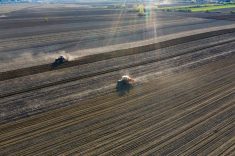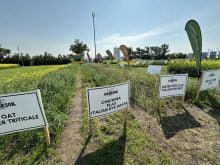Some say life success is about being in the right place at the right time. These are part of the guiding principle behind 4R nutrient stewardship, which farmers know well. Kelly Turkington, an AAFC pathology research scientist based in Lacombe, Alta., said the same principles can be applied to disease management. Speaking at the Farm Forum Event last November, Turkington said returning to this foundational knowledge can help farmers get the most out of their disease management tools.
The 4Rs revisited
Read Also

Claas brings 1000 Series SP forage harvesters to Canada
In mid-August, Claas unveiled its new line of Jaguar forage harvesters at an event in Visalia, California, deep in the heart of that state’s dairy region.
According to Fertilizer Canada, programs for 4R nutrient stewardship — applying the right source at the right rate, right time and right place — balances the goals of farmers, industry and government to improve fertilizer efficiency, crop production and on-farm economics, while minimizing environmental concerns related to agriculture.
These principles can also be applied to disease management, said Turkington.
Apply the right tools, in the right place, at the right rate and at the right time for your best disease management outcomes.
Right tool
When selecting the right tool for disease management, farmers should consider what issues they face on their farms. In some cases, solutions will be field specific, said Turkington. For example, in the case of cereal rust, one of the best tools is host resistance.
“A good variety with a good level of resistance will mitigate pretty well all of the risk you have in terms of rust and its impact on yield,” said Turkington.

More recently, growers have been dealing with bacterial leaf spot and leaf streak issues in a variety of crops. In some cases, growers assumed they were dealing with a fungal leaf disease — something like tan spot or septoria in wheat or net blotch or scald in barley — when, in reality, they were dealing with a bacterial pathogen.
“Spraying a fungicide will have no effect whatsoever,” said Turkington.
Scouting is key to selecting the right tool.
“If you’re not actively out in that crop scouting what you have there … getting the symptoms confirmed in terms of what is causing those issues, you may look at using the wrong tool to try to mitigate that risk,” said Turkington.
Depending on the source of the disease, crop rotation as well as seed selection are two good mitigation strategies, he added.
Right place
Knowing where to look for disease is also crucial to proper management. For instance, those farmers focusing primarily on in-crop diseases may be missing the boat in terms of mitigating the risks associated with seed-borne diseases or seed health issues, said Turkington.
“There you may look at using a good seed treatment, good application technology and a product that is registered for the disease issues that you have,” he said.
Turkington suggested working with a seed testing lab to get a disease screen done on seed intended for planting. Doing so helps farmers prepare for potential disease issues. If there are very high levels of seed infection, the seed may be too compromised already in terms of germination and vigour, and growers may be better off looking at an alternative seed source, he advised.
Right rate and time
When it comes to selecting the right rate, the same principles used for fertilizer management can be applied to disease management strategies as well. In many cases, said Turkington, applying a reduced rate may actually compromise the level of control. This, in turn, can affect yield, quality and grade.
For example, Turkington referred to complex disease matters in wheat, where seedling issues, leaf disease and fusarium head blight may all be of concern. Both the right timing and the right rate are important here, as the crop advances through different growth stages.
“You might need to put a fungicide on to mitigate an emerging leaf disease issue or a rust issue like stripe rust,” said Turkington. “But then, you’ve also got to come back in and utilize a fungicide to get some suppression of fusarium head blight.”
Put it all together
In many cases, when it comes to disease pressure, growers will need a combination of tools. A prime example of this is fusarium head blight, which is caused by Fusarium graminearum. Relying on varietal disease resistance alone is not going to cut it, said Turkington. Neither is solely relying on fungicide applications or crop rotation.
“You need to look at a combination of strategies to mitigate that disease,” said Turkington. “That, often, is pretty difficult, even when you use multiple tools for fusarium head blight.”
Growers who want to get the most out of the tools they have — or will have — need to apply this foundational knowledge, Turkington said. This involves first gaining a complete understanding of the crop and crop diseases as well as the available tools to mitigate disease — then apply the right tools, in the right place, at the right rate and at the right time.















